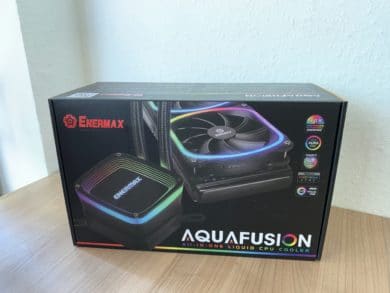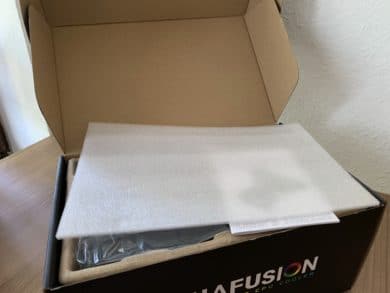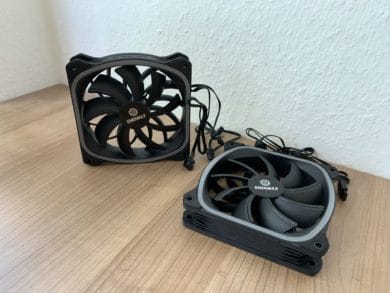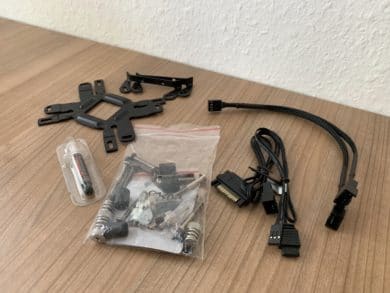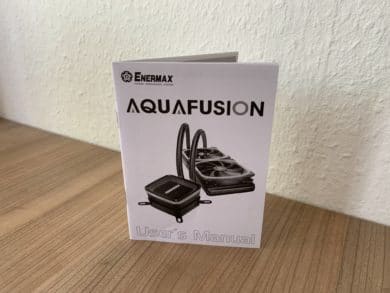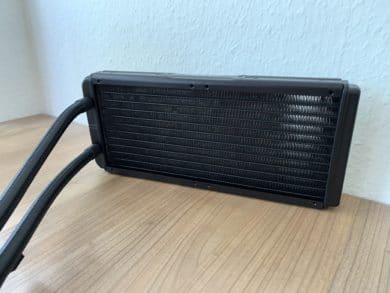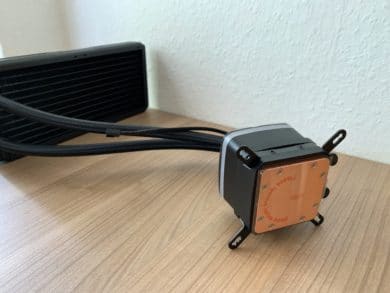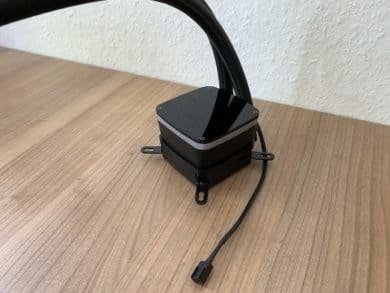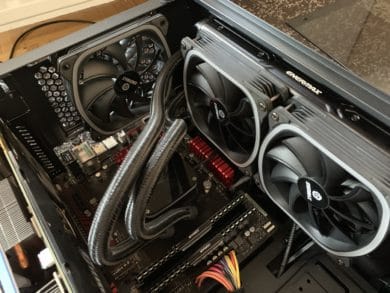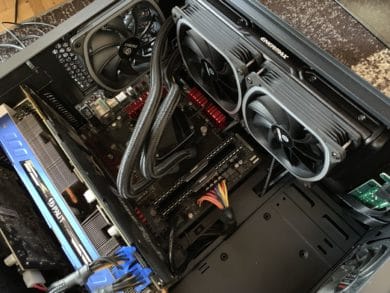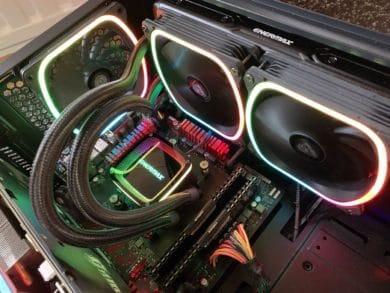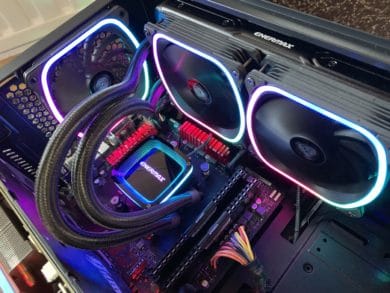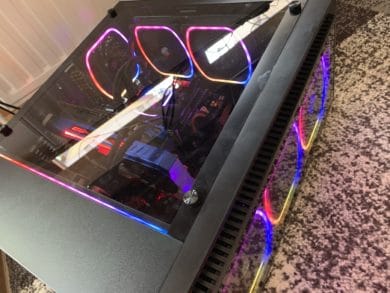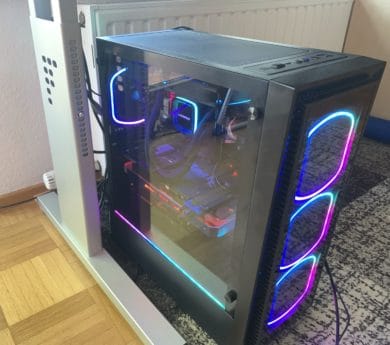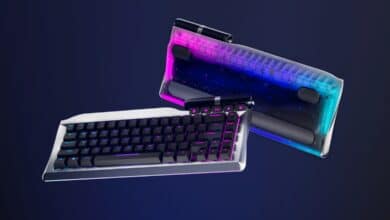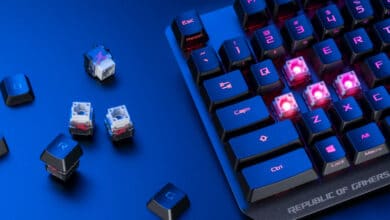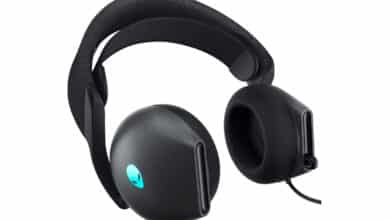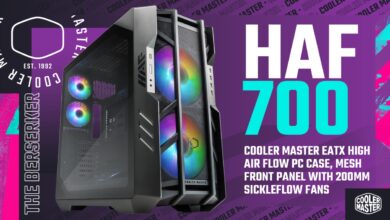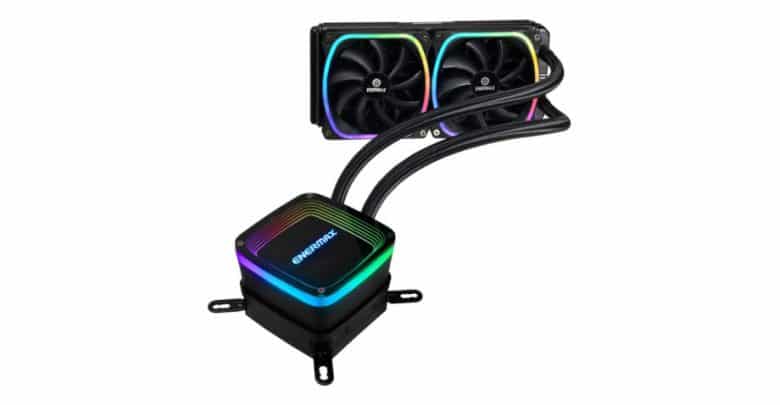
Two things are becoming increasingly popular in the computer hardware market: RGB lighting and AiO CPU coolers. Enermax merges these two trends and introduces the AquaFusion 240, a controllable RGB-AiO-CPU cooler. In our test, we want to find out how the AquaFusion performs and which of the two trends Enermax does better justice to.
Technical Details
The Enermax AquaFusion 240* is available since the beginning of 2019. There is also a small variant, the Enermax AquaFusion 120*, whose radiator can only hold one instead of two 120mm fans. According to the description 320 W can be dissipated with the small model and 350 W with the large model.
Radiator:
| Dimensions: | 274 x 120 x 27 mm |
| Material: | Aluminium (painted black) |
CPU cooler:
| Height: | 53.7 mm |
| Base plate material: | Nickel plated copper |
| Hose length: | 400 mm |
Compatibility:
| Intel socket: | LGA 2066, 2011-3, 2011, 1366, 1156, 1155, 1151, 1150 |
| AMD socket: | AM4, AM3+, AM3, AM2+, AM2, FM2+, FM2, FM1 |
Fan:
| Type: | 2x 120 mm (SquA RGB) |
| Speed: | 500 – 2,000 rpm |
| Delivery volume: | 40.5 – 173.6 m³/h |
| Static pressure: | 0.7 – 3.6 mmH2O |
| Volume: | 17 – 32.6 dB(A) |
| Connection: | 4-pin PWM, 4-pin RGB |

Packaging and Scope of Delivery
The Enermax AquaFusion arrives safely in a stylish and sufficiently padded package.
In addition to the AiO water cooling itself, the following accessories are included in the box:
- 2x 120 mm SquA RGB fan
- Miscellaneous cables and parts for controlling and connecting the RGB lighting
- Mounting kits for some motherboard platforms
- heat conduction paste
- Manual
The accessories are more than sufficiently dimensioned, all important parts are included. Especially the RGB adapters for MSI and Gigabyte mainboards know how to please.
Workmanship and Design
The workmanship of the Enermax AquaFusion 240 is very good. No significantly bent lamellae could be detected on the radiator. The pump housing is very stable and the fixings on the hoses are perfect. However, the latter are quite stiff.
Except for the lettering on the fans and radiator, the elements are completely black except for the LED area.
In terms of design, the CPU block is the main focus. According to the manufacturer, a 3D layer design with Aurabelt™ should provide unique lighting effects. But more about that later.
The Installation
The assembly of the AquaFusion was somewhat problematic. But one after the other.
The included SquA RGB fans can be easily attached to the radiator. Due to a light rubber coating, scratches and vibrations during operation can be avoided.
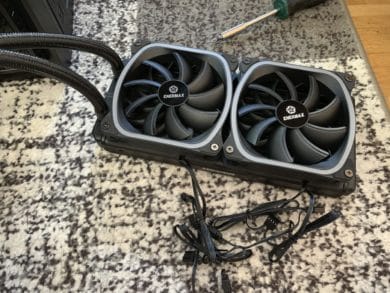
After the installation of the radiator with the mounted fans we continued with the compact CPU block. In our case two holders for Intel systems were already mounted in advance, which could easily be removed. Now comes the difficult part: the backplate of the cooler. According to the instructions it is not secured properly before screwing on the CPU block. The result is that the backplate can slip or fly out. As a simple solution, the case must ideally lie completely on the backplate – accessible by a book or similar between it and the floor.
After the successful assembly, all components are firmly and securely seated in the intended place.
Lighting
With the SquA RGB fans and the illuminated CPU block, the AquaFusion provides comprehensive RGB lighting.
The lighting of the CPU block is particularly noteworthy: the 3D layer design is revealed here.
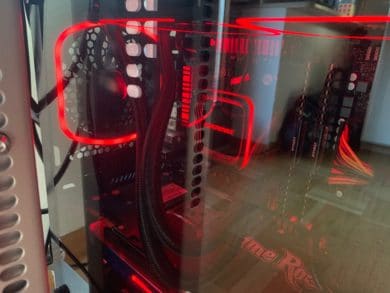
Especially in combination with the case Enermax StarryFort SF30 you get a very cool look. All LED elements of the case and the cooler can be controlled together via the LED controller of the case.
If the AiO water cooling is not to be used with the housing, the LEDs are controlled via the supplied switch. Various colour effects are also available here. In addition, a colour can be permanently displayed or completely deactivated.
Cooling Capacity and Volume
Let’s get to one of the most important parts: How does the AquaFusion 240 perform in practice? It competes against the Alphacool Eisbaer LT240, which uses alternative fans.
We test both cooling systems with 500 and 900 RPM. In addition the Enermax is operated with maximum RPM. Since the pump makes quiet noises at both AiO’s at full voltage, the voltage was reduced to 7 V by an adapter. To simulate the temperature under full load, Prime95 was used.
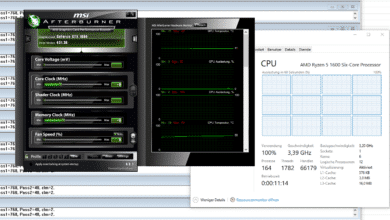
The room temperature for each test was approx. 24 ° C. At maximum speed, the cooling performance is impressive, but so is the volume. At 900 RPM the volume decreases significantly and should be quiet enough for most people. Compared to the Alphacool cooler, the cooling performance is at almost the same level.
At 500 RPM, the AquaFusion fans are barely audible. Compared to the Alphacool, however, the cooling performance is clearly worse.
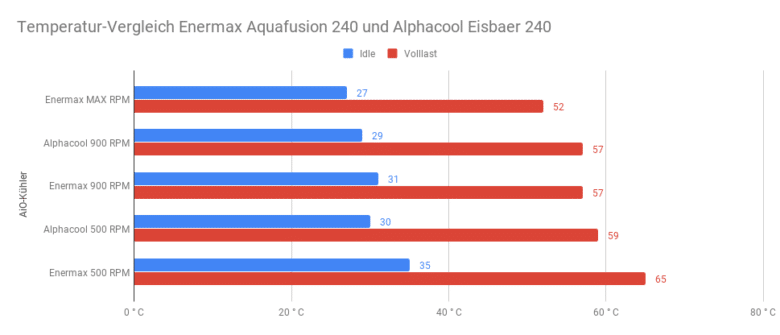
In summary, it can be said that the cooling performance of the Enermax AiO is very good, unless the fans turn too slowly. Here the cooling performance decreases strongly compared to the competition. The sweet spot of cooling and volume should be between 700 and 1000 RPM, depending on the user.
Conclusion of the Enermax AquaFusion 240 Review
Enermax offers a good product with AquaFusion. The workmanship is top and the lighting looks chic. As long as the supplied fans are operated at the correct speed, the cooling performance is good and the volume quiet.
The AquaFusion thus meets the trends of AiO cooling and RGB lighting, but neither is taken to a new level. All in all, the AquaFusion is recommended, especially for fans of RGB lighting. In the next version, however, Enermax will have to improve the installation and especially the mounting system.
Enermax AquaFusion 240
Design
Features
Cooling Performance
Assembly
Volume
Value for Money
Very colourful RGB-AiO-CPU cooling with fiddly mounting.

